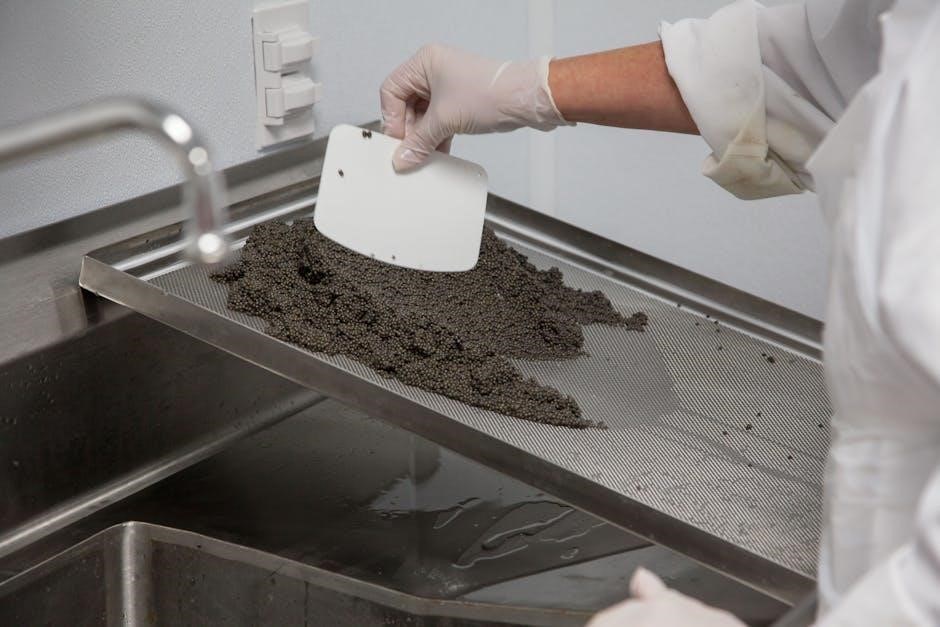
Creating a food storage list for 1 year requires planning and research to ensure a balanced diet and sufficient supplies, using online resources and pdf guides effectively always.
Importance of Rotating Food Supply
Rotating food supply is crucial to maintain freshness and usability, as expired or spoiled food can be detrimental to health and waste resources. A well-rotated food supply ensures that older items are consumed before they expire, making way for new purchases. This practice also helps to identify and replace items that are near expiration, reducing food waste and saving money. By rotating food supply twice a year, individuals can ensure that their stored food remains nutritious and safe to eat. Effective rotation also involves tracking expiration dates, storage conditions, and consumption patterns to optimize food storage and minimize losses. Proper food rotation is essential for a successful food storage list for 1 year, as it guarantees a steady supply of fresh and nutritious food. Regular rotation also helps to maintain a balanced diet and prevents the accumulation of expired or spoiled food.
Making a List of Family Members and Their Needs
To create an effective food storage list, it’s essential to make a list of all family members, including their names, ages, and any special dietary needs. This list should indicate if anyone has allergies, diabetes, or other health conditions that require specific foods or restrictions. By considering the unique needs of each family member, individuals can ensure that their food storage list is tailored to provide a balanced and nutritious diet for everyone. This list can be used to guide food purchases and storage, helping to prevent shortages or oversights. A comprehensive list of family members and their needs is a critical step in creating a personalized food storage plan, allowing individuals to prioritize their food storage efforts and make informed decisions about their food supply. This list should be regularly updated to reflect any changes in family members’ needs.

Creating a Food Storage List
Start by identifying essential food items and organizing them into categories using online pdf guides and resources effectively always for planning purposes.
List of Staple Foods
Compiling a list of staple foods is crucial for a 1-year food storage plan, including grains like rice, pasta, and cereals, as well as canned goods and dried legumes.
These foods provide sustenance and can be stored for extended periods when properly packaged and maintained, according to online resources and pdf guides.
A well-stocked pantry with staple foods ensures a steady supply of nutrients and reduces reliance on external food sources, which can be unpredictable in emergency situations.
By prioritizing staple foods, individuals can create a robust food storage plan that meets their nutritional needs for an extended period, using online pdf guides and resources effectively for planning purposes always.
Posting and Updating the List
Regular updates to the list are necessary to reflect changes in stock levels, expiration dates, and new additions, which can be done using online pdf guides and resources.
By reviewing and updating the list periodically, individuals can identify areas where supplies need to be replenished or rotated, preventing spoilage and waste, and maintaining a well-organized food storage system.
This process also helps to ensure that the list remains accurate and reliable, providing a valuable tool for managing food storage and planning for the future, with the use of p and h3 tags for organization and clarity always.

Freezer Food Storage
Making a List of Frozen Foods
The list should include the type and quantity of each frozen food item, as well as the date it was frozen and its expected shelf life.
This information can be used to plan meals and ensure that frozen foods are consumed before they spoil, using online resources and pdf guides for reference. By making a list of frozen foods, individuals can ensure that their food storage plan is comprehensive and effective, and that they are prepared for any situation.
Using online tools and resources can also help with meal planning and grocery shopping.
Planning Meals
A meal plan should be created to ensure that all food storage items are used before they expire, and that meals are nutritious and balanced.
The plan should take into account the ingredients and cooking methods available, as well as any dietary restrictions or preferences.
Using online resources and pdf guides can help with meal planning, providing recipes and ideas for using stored food items.
A meal plan can be created for a week, month, or even a year, and can be adjusted as needed to ensure that food storage items are used efficiently.

Best Canned Foods for Storage
Meats and Vegetables
Other Convenience Foods

Storage Containers and Conditions
Shelf Stability and Storage Containers
Shelf stability is crucial for long-term food storage, and using the right containers is essential. According to online resources, air-tight and water-tight containers are best for storing food. The use of sealed number 10 cans or plastic 5-gallon buckets can help maintain freshness. It is also important to consider the material of the containers, as some may react with certain types of food. By choosing the right containers, individuals can ensure their food storage list for 1 year remains fresh and usable. Proper storage conditions, such as cool and dark places, also play a significant role in maintaining shelf stability. With the right containers and conditions, food can be stored for up to 25 years, making it a reliable option for emergency situations. This information can be found in various online guides and pdf resources.
Storage Area Conditions
The conditions of the storage area play a significant role in maintaining the quality of the food. According to online resources, a cool and dark place is ideal for storing food. The amount of light and heat in the storage area can affect the shelf life of the food. It is recommended to store food in an area with a consistent temperature and humidity level. This can help prevent spoilage and maintain the nutritional value of the food. A well-ventilated area can also help prevent moisture buildup, which can lead to mold and bacterial growth. By controlling the storage area conditions, individuals can ensure their food storage list for 1 year remains fresh and usable for a longer period. Proper storage conditions can be found in various online guides and pdf resources, providing valuable information for food storage.



